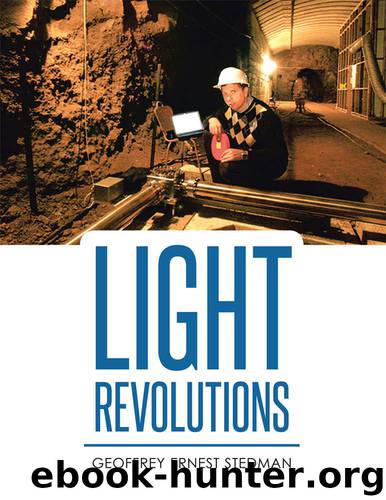Light Revolutions by Geoffrey Ernest Stedman

Author:Geoffrey Ernest Stedman
Language: eng
Format: mobi, epub
ISBN: 9781493137770
Publisher: Xlibris NZ
Published: 2015-06-17T16:00:00+00:00
6 Quantum Mechanics
INTRODUCTION
If relativity is peculiar from a classical viewpoint, and if its predictions are highly counter-intuitive and mind bending, Quantum Mechanics is, if anything, even more so. Both these revolutions, dating from the 1920’s show that our classical prejudices regarding time, space and matter are wrong at a fundamental level. Murray Gell- Mann (a Nobel Laureate in physics was a key discoverer of the quarks structure of the proton and neutron when at Canterbury University 1978) said, “Deep down inside, no-one understands Quantum Mechanics.” If one thinks, “why bother with Quantum theory then?” you might say the answer is. “Because that is what Nature requires.” Another Nobel Laureate indeed classmate and colleague of Gell-Mann, Richard Feynman, once said in Robb lectures at Auckland University (New Zealand, 1979) 1 “I’m going to describe how Nature is,’ ‘and if by any chance you don’t like how nature is, that’s going to get in the way of your understanding it.’ ‘If you don’t like it then you can go live somewhere else.’ [i.e. some other universe] ‘I can’t explain why Nature works in this peculiar way. Again we are forced to face with the reality of the world around we have no choice but to accept it’. These are problems that physicists have learned to deal with and live with of necessity of course, for we live here. If anyone puts the question of what the essential content of Quantum Mechanics actually is, it centres on a set of elaborate mathematical recipes. Armed with these, one can in principle compute the result of any experiment with small particles. The first approach of a physicist is to learn the vital mathematical rules, then verify them in checking experiments and so learn to use these rules. And indeed we physicists believe that we have found them and that they are unique, and adequate for all experiments that one can do today.. In the work of Feynman and his book ‘QED’ 2 he was actually at some considerable pains to help a new physics student from becoming too involved with some of the deepest questions in the topic. Feynman described in outline the full machinery of quantum theory using an extraordinary and simple pictorial construction. He presents various geometric contractions involving the adding of a lot of arrows head to tail to show why light moves linearly, reflects at a mirror and does all the other peculiar wavy things that a light wave does. The construction has the effect of avoiding even the idea that the square root of –1 is a number an idea essential for quantum theory. When Feynman explains this he said “No matter how many arrows (amplitudes) we draw, add or multiply, our objective is to calculate a single final arrow, for the whole history.” I will not attempt to explain this, (see the earlier ref to Feynmans book QED) that would have to assume far too much mathematical ability and physical science knowledge for the general reader. Feynman’s account is one place to go for as simple an exposition as possible.
Download
This site does not store any files on its server. We only index and link to content provided by other sites. Please contact the content providers to delete copyright contents if any and email us, we'll remove relevant links or contents immediately.
| Automotive | Engineering |
| Transportation |
Whiskies Galore by Ian Buxton(41524)
Introduction to Aircraft Design (Cambridge Aerospace Series) by John P. Fielding(32885)
Small Unmanned Fixed-wing Aircraft Design by Andrew J. Keane Andras Sobester James P. Scanlan & András Sóbester & James P. Scanlan(32569)
Craft Beer for the Homebrewer by Michael Agnew(17927)
Turbulence by E. J. Noyes(7693)
The Complete Stick Figure Physics Tutorials by Allen Sarah(7135)
Kaplan MCAT General Chemistry Review by Kaplan(6590)
The Thirst by Nesbo Jo(6432)
Bad Blood by John Carreyrou(6271)
Modelling of Convective Heat and Mass Transfer in Rotating Flows by Igor V. Shevchuk(6219)
Learning SQL by Alan Beaulieu(6029)
Weapons of Math Destruction by Cathy O'Neil(5823)
Man-made Catastrophes and Risk Information Concealment by Dmitry Chernov & Didier Sornette(5641)
Digital Minimalism by Cal Newport;(5388)
Life 3.0: Being Human in the Age of Artificial Intelligence by Tegmark Max(5182)
iGen by Jean M. Twenge(5157)
Secrets of Antigravity Propulsion: Tesla, UFOs, and Classified Aerospace Technology by Ph.D. Paul A. Laviolette(4974)
Design of Trajectory Optimization Approach for Space Maneuver Vehicle Skip Entry Problems by Runqi Chai & Al Savvaris & Antonios Tsourdos & Senchun Chai(4837)
Electronic Devices & Circuits by Jacob Millman & Christos C. Halkias(4741)
